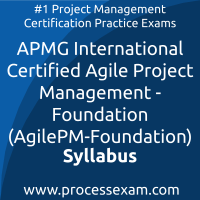 To achieve the professional designation of APMG International Agile Project Management - Foundation from the APMG International, candidates must clear the AgilePM Foundation Exam with the minimum cut-off score. For those who wish to pass the APMG International Agile Project Management Foundation certification exam with good percentage, please take a look at the following reference document detailing what should be included in APMG International AgilePM Foundation Level Exam preparation.
To achieve the professional designation of APMG International Agile Project Management - Foundation from the APMG International, candidates must clear the AgilePM Foundation Exam with the minimum cut-off score. For those who wish to pass the APMG International Agile Project Management Foundation certification exam with good percentage, please take a look at the following reference document detailing what should be included in APMG International AgilePM Foundation Level Exam preparation.
The APMG International AgilePM Foundation Exam Summary, Sample Question Bank and Practice Exam provide the basis for the real APMG International Certified Agile Project Management - Foundation (AgilePM-Foundation) exam. We have designed these resources to help you get ready to take APMG International Agile Project Management - Foundation (AgilePM Foundation) exam. If you have made the decision to become a certified professional, we suggest you take authorized training and prepare with our online premium APMG International Agile Project Management Foundation Practice Exam to achieve the best result.
APMG International AgilePM Foundation Exam Summary:
| Exam Name | APMG International Agile Project Management - Foundation |
| Exam Code | AgilePM Foundation |
| Exam Fee | USD $371 |
| Exam Duration | 40 Minutes |
| Number of Questions | 50 |
| Passing Score | 60% |
| Format | Multiple Choice Questions |
| Books / Trainings | Find a training provider |
| Schedule Exam | Book an exam |
| Sample Questions | APMG International AgilePM Foundation Level Exam Sample Questions and Answers |
| Practice Exam | APMG International Certified Agile Project Management - Foundation (AgilePM-Foundation) Practice Test |
APMG International Agile Project Management Foundation Syllabus Topics:
| Topic |
|---|
| Key Concepts |
| Scrum Overview |
| AgilePM Fundamentals |
| Individuals and Interactions |
|
Collaboration and Communication
|
| Project Lifecycle Framework |
| Requirements, Estimating and Prioritisation |
| Planning and Control |
| Risk Management and the Project Approach |
|
Governance, Compliance and the AgilePM Products
|
Both APMG International and veterans who’ve earned multiple certifications maintain that the best preparation for a APMG International AgilePM Foundation professional certification exam is practical experience, hands-on training and practice exam. This is the most effective way to gain in-depth understanding of APMG International AgilePM Foundation Level concepts. When you understand techniques, it helps you retain APMG International Agile Project Management Foundation knowledge and recall that when needed.
